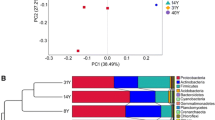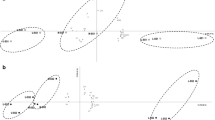Abstract
We compared the size, culturability, diversity, and dominant species similarity of the bacterial communities of Leucanthemopsis alpina (L.) Heywood rhizosphere and adjacent bare soil (interspace) along a chronosequence of soil development time (5, 50, and 70 years) in the forefield of the Dammaglacier (Switzerland). We found no evidence that the size of the bacterial community was significantly affected by either soil age or the presence of L. alpina. In contrast, the proportion of the bacterial community that could be cultured on nonselective agars, and which was taken as an indication of the proportion of r-selected populations, was significantly higher in the 50- and 70-year-old soils than in the 5-year-old soil, and was also significantly higher in the rhizosphere of L. alpina at all time points. RDA indicated significant correlations between the increased culturability of the bacterial community over time and increasing concentrations of labile N, and between the increased culturability in the rhizosphere and increased concentrations of labile C and N. HaeIII-amplified ribosomal DNA (rDNA) restriction analysis of a library of 120 clones of 16S rDNA revealed 85 distinct phylotypes. Hurlbert's probability of interspecific encounter (PIE) values derived from this library ranged from 0.95 to 1.0, indicating a very high genetic diversity. There was no significant difference in the PIE values of rhizosphere and interspace communities. Detrended correspondence analysis (DCA) of 16S ribosomal RNA (rRNA) denaturing gradient gel electrophoresis (DGGE) community profiles clearly distinguished the rhizosphere from the interspace community in the 5-year-old soils and also clearly distinguished between these communities and the rhizosphere and interspace communities of the 50- and 70-year-old soils. However, 16S rRNA DGGE revealed little difference between rhizosphere and interspace communities in the 50- and 70-year-old soils. The relative similarity of the 16S rRNA profiles strongly reflected labile carbon and nitrogen availability. Overall, our results suggest that improved C and N availability in the rhizosphere of L. alpina increases the size of r-selected bacterial species populations, but that the influence of L. alpina depends on soil age, being maximal in the youngest soils and minimal in the oldest. The reduced influence of L. alpina in the older soils may reflect a feedback between improved nutrient availability and reduced rhizodeposition.








Similar content being viewed by others
References
Altschul, SF, Gish, W, Miller, W, Myers, EW, Lipman, DJ (1990) Basic local alignment search tool. J Mol Biol 215: 403–410
Amann, RI, Luwig, W, Schleifer, KH (1995) Phylogenetic identification and in situ detection of individual microbial cells without cultivation. Microbiol Rev 59: 143–169
Baleshtra, GM, Misaghi, IJ (1997) Increasing the efficiency of the plate counting method for estimating bacterial diversity. J Microbiol Methods 30: 111–117
Barber, DA, Martin, JK (1976) The release of organic substances by cereal roots into soil. New Phytol 76: 69–80
Brodie, E, Edwards, S, Clipson, N (2002) Bacterial community dynamics across a floristic gradient in a temperate upland grassland ecosystem. Microb Ecol 44: 260–270
Burga, CA, Frauenfelder, R, Ruffet, J, Hoelzle, M, Kääb, A (2004) Vegetation on Alpine rock glacier surfaces: a contribution to abundance and dynamics on extreme plant habitats. Flora 199: 505–515
Bürgmann, H, Pesaro, M, Widmer, F, Zeyer, J (2001) A strategy for optimizing quality and quantity of DNA extracted from soil. J Microbiol Methods 45: 7–20
Chabrerie, O, Laval, K, Puget, P, Desaire, S, Alard, D (2003) Relationship between plant and soil microbial communities along a successional gradient in a chalk grassland in north-western France. Appl Soil Ecol 24: 43–56
Chapin, FS III, Walker, LR, Fastie, CL, Sharman, LC (1994) Mechanisms of primary succession following deglaciation at glacier bay, Alaska. Ecol Monogr 64: 149–175
Cheng, W, Zhang, Q, Coleman, DC, Carroll, CR, Hoffman, CA (1996) Is available carbon limiting microbial respiration in the rhizosphere? Soil Biol Biochem 28: 1283–1288
Cole, JR, Chai, B, Marsh, TL, Farris, RJ, Wang, Q, Kulam, SA, Chandra, S, McGarrell, DM, Schmidt, TM, Garrity, GM, Tiedje, JM (2003) The Ribosomal Database Project (RDP-II): previewing a new autoaligner that allows regular updates and the new prokaryotic taxonomy. Nucleic Acids Res 31: 442–443
Deubel, A, Gransee, A, Merbach, W (2000) Transformation of organic rhizodepositions by rhizosphere bacteria and its influence on the availability of tertiary calcium phosphate. J Plant Nutr 163: 387–392
Duineveld, B, Rosado, AS, van Elsas, JD, van Veen, JA (1998) Analysis of the dynamics of bacterial communities in the rhizosphere of the Chrysanthemum via denaturing gradient gel electrophoresis and substrate utilization patterns. Appl Environ Microbiol 64: 4950–4957
Duineveld, B, Kowalchuk, GA, Keijzer, A, van Elsas, JD, van Veen, JA (2001) Analysis of bacterial communities in the rhizosphere of Chrysanthemum via denaturing gradient gel electrophoresis of PCR-amplified 16S rRNA as well as DNA fragments coding for 16S rRNA. Appl Environ Microbiol 67: 172–178
Egli, M, Mirabella, A, Fitze, P (2001) Weathering and evolution of soils formed on granitic, glacial deposits: results from chronosequences of Swiss alpine environments. Catena 45: 19–47
Ekblad, A, Nordgren, A (2002) Is growth of soil microorganisms in boreal forests limited by carbon or nitrogen availability? Plant Soil 242: 115–122
Felske, A, Wolterink, A, Van Lis, R, De Vos, WM, Akkermans, ADL (2000) Response of a soil bacterial community to grassland succession as monitored by 16S rRNA levels of the predominant ribotypes. Appl Environ Microbiol 66: 3998–4003
Garland, JL, Cook, KL, Adams, JL, Kerkhof, L (2001) Culturability as an indicator of succession in microbial communities. Microb Ecol 42: 150–158
Germida, JJ, Siciliano, SD, de Freitas, JR, Seib, AM (1998) Diversity of root-associated bacteria associated with field-grown canola (Brassica napus L.) and wheat (Triticum aestivum L). FEMS Microbiol Ecol 26: 43–50
Gotelli, NJ, Entsminger, GL (2001) EcoSim: Null Models Software for Ecology. Version 7.0. Acquired Intelligence Inc. & Kesey-Bear, Jericho, VT
Hamelin, J, Fromin, N, Tarnawski, S, Teyssier-Cuvelle, S, Aragmo, M (2002) nifH gene diversity in the bacterial community associated with the rhizosphere of Molinia coeruea, an oligonitrophilic perennial grass. Environ Microbiol 4: 477–481
Hoelzle, M, Vonder-Mühll, D, Maisch, M (1999) Die Gletscher der Schweizer Alpen im Jahr 1997/1998. Die Alpen 10: 28–40
Hurlbert, SH (1971) Nonconcept of species diversity—critique and alternative parameters. Ecology 52: 577–586
Hütsch, BW, Augustin, J, Merbach, W (2002) Rhizodeposition—an important source for carbon turnover in soils. J Plant Nutr 165: 397–407
Jonasson, S, Michelsen, A, Schmidt, IK, Nielsen, EV, Callaghan, TV (1995) Microbial biomass C, N, and P in two arctic soils and responses to addition of NPK fertilizer and sugar: implications for plant nutrient uptake. Oecologia 106: 507–515
Kaye, JP, Binkley, D, Rhoades, C (2003) Stable soil nitrogen accumulation and flexible organic matter stoichiometry during primary floodplain succession. Biogeochemistry 63: 1–22
Körner, C (1999) Alpine Plant Life. Springer-Verlag, Berlin, pp 63–74
Kuske, CR, Ticknor, LO, Miller, ME, Dunbar, JM, Davis, JA, Barns, SM, Belnap, J (2002) Comparison of soil bacterial communities in rhizospheres of three plant species and the interspaces in an arid grassland. Appl Environ Microbiol 68: 1854–1863
Langer, U, Böhme, L, Böhme, F (2004) Classification of soil microorganisms based on growth properties: a critical view of some commonly used terms. J Plant Nutr Soil Sci 167: 267–269
Lilley, AK, Fry, JC, Bailey, MJ, Day, MJ (1996) Comparison of aerobic heterotrophic taxa isolated from four root domains of mature sugar beet (Beta vulgaris). FEMS Microbiol Ecol 21: 231–242
Lipson, DA, Schmidt, SK, Monson, RK (1999) Links between microbial population dynamics and nitrogen availability in an alpine ecosystem. Ecology 80: 1623–1631
Ludwig, W, Strunk, O, Westram, R, Richter, L, Meier, H, Buchner, A, Lai, T, Steppi, S, Jobb, G, Förster, W, Brettske, I, Gerber, S, Ginhart, AW, Gross, O, Grumann, S, Hermann, S, Jost, R, König, A, Liss, T, Lümann, R, May, M, Nonhoff, B, Reichel, B, Strehlow, R, Stamatakis, A, Stuckmann, N, Vilbig, A, Lenke, M, Ludwig, T, Bode, A, Schleifer, K-H (2004) ARB: a software environment for sequence data. Nucleic Acids Res 32: 1363–1371
Margesin, R, Spröer, C, Schumann, P, Schinner, F (2003) Pedobacter cryonitis sp. nov., a facultative psychrophile from alpine glacier cryoconite. Int J Syst Evol Microbiol 53: 1291–1296
Marilley, L, Aragno, M (1999) Phylogenetic diversity of bacterial communities differing in degree of proximity of Lolium perenne and Trifolium repens roots. Appl Soil Ecol 13: 127–136
McCaig, AE, Glover, LA, Prosser, JI (2001) Numerical analysis of grassland bacterial community structure under different land management regimens by using 16S ribosomal DNA sequence data and denaturing gradient gel electrophoresis banding patterns. Appl Environ Microbiol 67: 4554–4559
Merbach, W, Mirus, E, Knof, G, Remus, R, Ruppel, S, Russow, R, Gransee, A, Schultze, J (1999) Release of carbon and nitrogen compounds by plant roots and possible ecological importance. J Plant Nutr 162: 373–383
Mulvaney, RL (1996) Nitrogen-inorganic forms. In: Methods of Soil Analysis, Part 3. Chemical Methods—SSSA Book Series No. 5. Soil Science Society of America and American Society of Agronomy, Madison, WI, pp 1123–1184
Neter, J, Wasserman, W, Kutner, MH (1990) Applied Linear Statistical Models, 3rd ed., Irwin, Boston, MA, pp 741–744
Nübel, U, Engelen, B, Felske, A, Snaidr, J, Weishuber, A, Amann, RI, Ludwig, W, Backhaus, H (1996) Sequence heterogeneities of genes encoding 16S rRNAs in Paenibacillus polymyxa detected by temperature gradient gel electrophoresis. J Bacteriol 178: 5636–5643
Oerlemans, J (1994) Quantifying global warming from the retreat of glaciers. Science 264: 243–245
Ohtonen, R, Fritze, H, Pennanen, T, Jumpponen, A, Trappe, J (1999) Ecosystem properties and microbial community changes in primary succession on a glacier forefront. Oecologia 119: 239–246
Roberts, MS, Garland, JL, Mills, AL (2004) Microbial astronauts: assembling microbial communities for advanced life support systems. Microb Ecol 47: 137–149
Sambrook, J, Fritsch, EF, Maniatis, T (1989) Molecular Cloning, A Laboratory Manual. Cold Spring Harbor Laboratory Press, Cold Spring Harbor, NY
Sigler, WV, Zeyer, J (2002) Microbial diversity and activity along the forefields of two receding glaciers. Microb Ecol 43: 397–407
Smith, JL, Paul, EA (1990) The significance of soil microbial biomass estimations. In: Bollag J, Stotsky G (Eds.) Soil Biochemistry, vol. 6. Marcel Dekker, New York, pp 357–396
Spreafico, M, Weingartner, R, Leibundgut, C (1992) Hydrological Atlas of Switzerland. Landeshydrologie und geologie, Bern, Switzerland
Ter Braak, CJF, Prentice, IC (1988) A theory of gradient analysis. Adv Ecol Res 18: 271–318
Thomas, GW (1996) Soil pH and soil acidity. In: Methods of Soil Analysis, Part 3. Chemical Methods—SSSA Book Series No. 5. Soil Science Society of America and American Society of Agronomy, Madison, WI, pp 475–490
Tscherko, D, Hammesfahr, U, Marx, M-C, Kandeler, E (2004) Shifts in rhizosphere microbial communities and enzyme activity of Poa alpina across an alpine chronosequence. Soil Biol Biochem 36: 1685–1698
Tscherko, D, Rustemeier, J, Richter, A, Wanek, W, Kandeler, E (2003) Functional diversity of the soil microflora in primary succession across two glacier forelands in the Central Alps. Eur J Soil Sci 54: 685–696
Westover, KM, Kennedy, AC, Kelley, SE (1997) Patterns of rhizosphere microbial community structure associated with co-occurring plant species. J Ecol 85: 863–873
Wieland, G, Neumann, R, Backhaus, H (2001) Variation of microbial communities in soil, rhizosphere, and rhizoplane in response to crop species, soil type, and plant development. Appl Environ Microbiol 67: 5849–5854
Zarda, B, Hahn, D, Chatzinotas, A, Schönhuber, W, Neef, A, Amann, RI, Zeyer, J (1997) Analysis of bacterial community structure in bulk soil by in situ hybridization. Arch Microbiol 168: 185–192
Zhou, J, Chen, Z, Li, S (2003) Oxidation efficiency of different oxidants of persulfate method used to determine total nitrogen and phosphorus in solutions. Commun Soil Sci Plant Anal 34: 725–734
Author information
Authors and Affiliations
Corresponding author
Rights and permissions
About this article
Cite this article
Edwards, I.P., Bürgmann, H., Miniaci, C. et al. Variation in Microbial Community Composition and Culturability in the Rhizosphere of Leucanthemopsis alpina (L.) Heywood and Adjacent Bare Soil Along an Alpine Chronosequence. Microb Ecol 52, 679–692 (2006). https://doi.org/10.1007/s00248-006-9097-x
Received:
Accepted:
Published:
Issue Date:
DOI: https://doi.org/10.1007/s00248-006-9097-x




